ALTERNATIVES FOR CONVENTIONAL CONSTRUCTION METHODOLOGY AND MATERIALS
 -Manushi Sehulbhai Sheth (34)-
-Manushi Sehulbhai Sheth (34)-
Department of Architecture Faculty of Technology and Engineering
The Maharaja Sayajirao University of Baroda D.N. Hall, Pratapgunj Vadodara, India
JANUARY 2023
RESEARCH PAPER-1
ALTERNATIVES FOR CONVENTIONAL CONSTRUCTION METHODOLOGY AND MATERIALS
-GUIDED BYDr. Bhawana Vasudeva Ar. Chaitali Joshi
-SUBMITTED BYManushi Sheth_34
B.Arch V- First Semester (2022-23)
Department of Architecture Faculty of Technology and Engineering
The Maharaja Sayajirao University of Baroda D.N. Hall, Pratapgunj Vadodara, India

ARCHITECTURAL RESEARCH DISSERTATION
JANUARY 2023
DECLARATION
I MANUSHI SHETH, 2018033800119395,, give an undertaking that this research thesis entitled “ALTERNATIVES FOR CONVENTIONAL CONSTRUCTION METHODOLOGY AND MATERIALS” submitted by me, towards partial fulfilment for the Degree of Bachelor of Architecture at the Institute of Department of Architecture, The Maharaja Sayajirao University of Baroda contains no material that has been submitted or awarded for any degree or diploma in any university/school/institution to the best of my knowledge. It is a primary work carried out by me and I give assurance that no attempt of plagiarism has been made. It contains no material that is previously published or written, except where reference has been made. I understand that in the event of any similarity found subsequently with any published work or any dissertation work elsewhere; I would be responsible.
This research thesis includes findings based on literature review,expert interviews, documentation, surveys, discussions and my own interpretations.
Date: 10TH JANUARY, 2023
Name: MANUSHI SHETH
Roll number: 2018033800119395
College: The Maharaja Sayajirao University of Baroda Faculty of Technology and Engineering Department of Architecture
Research Thesis Title: ALTERNATIVES FOR CONVENTIONAL CONSTRUCTION METHODOLOGY AND MATERIALS
Signature
Dr. Bhawana Vasudeva
Head of the department of architecture
The Maharaja Sayajirao University of Baroda
Signature
Ar. Chaitali Joshi professor the department of architecture The Maharaja Sayajirao University of Baroda
ACKNOWLEDGEMENT
I am deeply indebted to my guides Dr. Bhawana Vasudeva and Ar. Chaitali Joshi for encouragement and helped me broaden my horizons throughout the research process. Thank you for your constant support and believing in my capabilities.
I would also thank my experts Ar. Yatin Pandya, Ar. Himanshu Patel, Ar. Vaishal Patel, Ar. Subhas Basu and Ar. Mansi Gadkari for giving their valuable opinions and discussions and helping me to move forward in the correct direction.
Finally, I would like to thank my Parents, Brother and all those who helped me completing my research work.
Thepaceofglobalwarmingisacceleratingandthescaleoftheimpactisdevastating.Thetimeforactionislimited-we areapproachingatippingpointbeyondwhichtheopportunitytoreversethedamageofCO2emissionswilldisappear. -EliotSpitzer-
ABSTRACT: ANSWERING WHY, WHAT AND WHERE
WHY?
The world population is growing at unprecedented rates and it is expected to reach 9.8 billion in 2050.
Today, non-sustainable exploitation of non-renewable resources of the Earth due to the high demand of conventional building materials is already an important environmental issue, and for sure, this concern will become of vital importance in the future with a rapidly growing world population.
For millennia men proved that they could live in a sustainable way. They lived in harmony with nature. They made use of it, yet respected it. People used earth as a raw material with sensitivity. The "modern" fashion of the 20th century created a break with the millennia old developments. Our Mother Earth has been spoilt and abused. The 21st century should find again the harmonious link between man, nature and spirit.
Utilization of Alternative Building Materials and Construction Techniques is a good way to effectively address this concern. I firmly believe that, “Refuse what you do not need; reduce what you do need; reuse what you consume; recycle what you cannot refuse, reduce, or reuse; and rot (compost) the rest."
And hence, trying to answer the question, “Are there any Alternatives to the Conventionally governed Construction Industry?” with the help of my research.
WHAT?
It is very devastating that humans have to ‘find solitude in concrete jungle’ due to lack of awareness and constant promotion of non-conventional and one time use materials. There are lack of single centers in India as well as around the world where one can experiment, explore and learn with all of these sustainable and low carbon emitting materials. India has a dearth of having sustainable practices under one roof with specialization course and hands on experience with materials.
This deficiency of not having an exploratory center for learning and innovation for the built environment can create drastic changes in the Building Construction industry if executed.
And so, I would like to progress my design thesis with the topic, “ ‘Ehsaas’- Center For Learning, Exploration And Innovation For The Built Environment.”
WHERE?
This Institution will have multiple target audiences such as Architects, Entrepreneurs, Fineartist, Sculptor,Young People In Vocational Training, Craftspeople And Artisans. etc including Domestic as well as International residents. Also creating this center near already established Institutions which work for Environment and Sustainability and more over with Materials. Therefore for this I have shortlisted some of the IITs and centers like CEE and TERI which promotes such practices. This center has to be located in such a place where people are aware of some of the technologies and have adaptability, inclination and respect for sustainable practices. Goa is to name a few cities which partially falls into the category.
Goa:
The history of Goa is intrinsically linked to the many centuries of Portuguese presence and rule. Before the arrival of the Portuguese, most Goan houses were mostly made of mud and had a thatched roof. Newly converted Christians embraced (or were encouraged to) a European aesthetic and lifestyle, though many aspects of their Goan cultural roots remained, resulting in a unique cultural mix, which affected everything, including the design of the houses.
Major INfluences:
● The Architectural Style of Portuguese-Built Churches.
● Adaptation of Foreign Ideas to Local Conditions and Using Local Materials
● Protecting the House and its Occupants from the Fierce Monsoons of Goa.
CHAPTER 0: GENERAL 0.1 BACKGROUND 0.2 RESEARCH QUESTION 0.3 AIM 0.4 OBJECTIVE 0.5 SCOPE
CHAPTER 1: LITERATURE REVIEW
1.0 INTRODUCTION
1.1 CONVENTIONAL BUILDING CONSTRUCTION
● 1.1.1 ADVANTAGES AND DISADVANTAGES OF CONVENTIONAL CONSTRUCTION.
● 1.1.2 MAIN DIFFERENCES BETWEEN CONVENTIONAL AND ALTERNATIVE BUILDING MATERIALS
CHAPTER 3: ARCHITECTURAL PROGRAM AND TENTATIVE SITE
3.0 OVERALL INSTITUTE CONCEPT
3.1 PROPOSED CURRICULUM
● 3.1.1 BASIC CONSTRUCTION COURSES
● 3.1.2 EARTH COURSE
● 3.1.3 BAMBOO COURSE
● 3.1.4 ‘WASTE AS RESOURCE’ COURSE
● 3.1.5 COMMON AREA PROGRAM
3.2 SITE SELECTION
● 3.2.1 Centre for Environment Education (CEE)
● 3.2.2 Centre for Environment Education (CEE) Centers in India
● 3.2.3 Sites Option
3.3 REFERENCES
1.2 ALTERNATIVE METHODS OF BUILDING CONSTRUCTION
● 1.2.1 ALTERNATIVE BUILDING TECHNIQUES
● 1.2.2 ALTERNATIVE BUILDING MATERIALS
1.3 LIST OF TYPES OF ALTERNATIVE BUILDING CONSTRUCTION
CHAPTER 2: CASE STUDIES
2.0 INTRODUCTION
2.1 CASE STUDIES
● 2.1.1 HUNNARSHALA
● 2.1.2 MANAV SADHNA ACTIVITY CENTER
● 2.1.3 GRAMAVIDYA
INDEX
0.1 BACKGROUND
The world population is growing at unprecedented rates and it is expected to reach 9.8 billion in 2050.
Today, non-sustainable exploitation of non-renewable resources of the Earth due to the high demand of conventional building materials is already an important environmental issue, and for sure, this concern will become of vital importance in the future with a rapidly growing world population.
Utilization of alternative building materials and construction techniques is a good way to effectively address this concern.
Also there is a lack of Institutions that promote essential technologies and materials that are not very energy consuming as well as recycling the waste our environment generates.
The combination of spaces consisting of co-working studios having architecture students, architects and civil engineers; and workshop areas of artisans; can contribute in making better built environments.
This deficiency of not having an exploratory center for learning and innovation for the built environment can create drastic changes in the Building Construction industry if executed.
0.2 RESEARCH QUESTION
Are there any Alternatives to the Conventionally governed Construction Industry?
0.3 AIM
1. To identify alternate methodology in building construction and materials in replacement or composition of conventional materials that are harmful to the environment.
2. To reduce or eliminate the environmental impact of the construction, simply by enlisting energy and resources that minimize the emissions through the use of rapidly renewable materials, local resources, recycled content, industrial/agricultural byproducts/wastes, etc.
0.4 OBJECTIVE
1. Identify the pros and cons of conventional methodology.
2. Identify substitute materials that could eliminate the environmental impact of the construction.
3. Cataloging the list of materials and technologies and providing their implications through case studies
4. Studying various platforms that allow us to experiment with materials and technologies.
0.5 SCOPE
1. The features of alternative construction are ecological features, economic features, environmental features, social and functional features.
2. Therefore, Alternative building materials and techniques can play a crucial role for sustainable construction towards sustainable development.
3. These methodologies are capable of meeting basic demands of sustainability which includes their ability to protect the environment, provide people with economic benefits as well as providing social value to the communities as well as the society at large.
4. This study provides an integration of the entire stakeholders in the construction industry, as it regards the utilization of the Alternative Building Materials and Construction for sustainable development.
5. This study has the scope of cataloging all Alternative Building Materials and Construction techniques so as to create awareness to all the potential clients and stakeholders of the industry regarding their availability and importance that has been established.
CHAPTER 0: GENERAL
1
1.0 INTRODUCTION
Construction is one of the fundamental processes of industrialization which is very important in terms of the development of the city, a country, and its economy. Also, construction is the process that is used to build buildings and so, it is important to the man at a personal and professional level.
Needless to say, man has searched for time immemorial for different materials and different methods to build strong and sustainable shelters and buildings which could house their livelihood processes. This has led to the discovery of various materials and techniques that could be used for this purpose. A broad classification of them in the current world are Conventional and Alternative building technology and materials.
1.1 CONVENTIONAL BUILDING CONSTRUCTION
Conventional building construction includes both- a) Construction Techniques b)Construction Materials. Conventional construction is a method of ordinary or standard construction. It commonly involves the utility of traditional materials, and remains within a particular set of parameters. In ordinary buildings, convention materials and construction techniques are used which are not concerned with energy consumption and material.
Conventional Construction is based on the assumption of “anticipated loading, common practices and use of traditional materials''. Conventional Construction is no longer adequate due to the construction of buildings of a typical size and shape, and the current demand for innovative materials, and the increased complexity and size of projects.
Conventional building materials are those materials that have been traditionally used to make buildings, monuments, structures, etc. They are defined by the term conventional because these materials are what people tend to use the most, and it has been that way for many years.
However, one of the biggest concerns these conventional building materials has brought forth is that they are not environmentally a very viable option.This is because the chemicals used in the process of creating these substances are elements of waste and pollution. Environmental issues were not noticed much before, as it was still in a better condition, and effects like Global Warming, Melting of IceCaps, etc. were not yet perceived as a big threat.
Not all conventional materials are environmental hazards though, because conventional materials also refer to traditional building materials, which involve stuff like mud and clay. But these materials have long been obsolete and not in use anymore, hence when we refer to conventional building materials, we refer to the environmentally threatening materials used in everyday construction.
The major components of conventional building materials are cement, a building material that has had its known use since the Romans, however, the mainstream use of Cement only came about 200 years ago. Some other conventional building materials are Glass, Plaster, Masonry Bricks and Steel.
CHAPTER 1:
LITERATURE REVIEW
2
1.1.1
ADVANTAGES AND DISADVANTAGES OF CONVENTIONAL CONSTRUCTION
Advantages of Conventional Construction identified in literature are:
● Accountability is caused by competitive selection based on an abundant supply of contractors, suppliers, consultants and subcontractors in the construction market who are willing to bid and execute work.
● Prior experience on how to execute construction tasks.
● The construction practices used have been tried and tested.
● Consultants have rates to work with from previous project estimates and this makes management of a conventional building project easier as available historical information can be used.
Disadvantages of Conventional Construction identified in literature are:
● It is based on history, and it is therefore difficult to determine when the construction techniques are inadequate.
● The general practices of conventional building construction are transferred from project to project even though the techniques do not necessarily suit the project at hand.
● It is noted that this one-size fits-all style of construction has led to other disadvantages, which include the carrying over of bad practices such as mismanagement and waste of resources.
● Also, the process of making these building substances leads to a lot of chemical wastage, which again brings forth environmental issues.
Hence it is required to use alternative eco-friendly building materials and technologies at various levels to not only reduce the cost of construction but also ensure no depreciation of the world's natural wealth. Also now, there is a need to put in organized efforts in the direction of using eco-friendly materials by replacing traditional materials. A positive role to be played by various government agencies, leading engineers and technologists, major users and entrepreneurs to bring sustainable development processes in the construction industry.
1.1.2 MAIN DIFFERENCES BETWEEN CONVENTIONAL AND ALTERNATIVE BUILDING MATERIALS
● The main difference between conventional and alternative building materials is that conventional building materials use non-recycled products that cause harm to the environment, while alternative building materials use recycled products, hence they are environmentally preferable.
● The conventional building material for flooring is cement, while that for alternative building materials is wood.
● Alternative building materials aim to reduce environmental pollution, while conventional building materials have no such aim.
● Conventional building materials use steel reinforcements, while alternative uses bamboo.
● Conventional building materials have brick walls, while alternative building materials have walls made of straw.
1.2 ALTERNATIVE METHODS OF BUILDING CONSTRUCTION
While technology and construction have progressed rapidly in recent years, allowing structures to be built taller and faster than ever, remnants of ancient monuments remind us that construction techniques from as long as hundreds of years ago had enormous merit as well. In fact, many of the innovations of antiquity serve as foundations of modern construction, with the Roman invention of concrete serving as a cogent example. Other essential ancient construction techniques, such as the arch and the dome, are now often considered stylistic flourishes.
Yet perhaps the most relevant reinterpretations of ancient construction today are those that do so in the interest of sustainability, renouncing high-energy modern construction methods in favor of older, more natural techniques. These reinterpretations have taken many different forms, ranging from the revived use of ancient materials to renewing ancient construction techniques.
3
1.2.1
ALTERNATIVE BUILDING TECHNIQUES
Alternative methods of construction involve a wide range of techniques and materials, and can be defined as a move away from traditional cavity wall construction using bricks and concrete blocks.
Achieving increasingly high standards of energy and environmental performance in new buildings can often most appropriately be achieved through the adoption of entirely different methods of construction. Benefits of using alternative methods of construction include:
● Ease of on-site implementation
● Resilience to supply chain issues
● Improved u-values
● Reduction of cold bridging
● Enhanced air-tightness
● Reduction in the environmental impact of construction materials
● Less waste.
Alternative building refers to construction methods that differ from mainstream modern architecture. They often use natural building materials, with a strong emphasis on sustainable design.
Recently, popular housing materials, such as treated lumber, synthetic insulation and certain paints (to name a few) have been exposed as harmful to both the environment and the inhabitants of the houses. There is no dispute over this issue as these matrials release the preservatives and poisons which it was soaked in over a predictable period of time. This is where alternative construction comes in.
While green buildings most often include high technology as part of their design, alternative buildings more often depend on traditional designs (reflecting wisdom which has evolved over many generations) and creative use of locally available materials and limited resources.
In many instances the buildings are less expensive to build and maintain, healthier to live in and more sturdy and reliable than those made from "conventional" materials.
1.2.2 ALTERNATIVE BUILDING MATERIALS
Discovery of natural inorganic binders like pozzolanic materials lead to the use of lime-pozzolan (LP) cement for construction purposes. Experience of using LP cement paved the way for the invention of Portland cement in 1824. Portland cement and steel brought revolutionary changes in the construction practices from the early part of the 20th century. Then plastics and plastic products entered the construction industry. Thus the new materials, which are available for use in construction, have many advantages over conventional materials being used presently.
The demand for building materials has been continuously rising with the increasing need for housing both in rural and urban areas. Commercial exploitation of traditional building materials by various industries has aggravated the situation. It has therefore become necessary to think over this problem seriously and to provide some sustainable solution to make the alternative materials available to solve the housing problem.
Bricks, cement, steel, aluminum, plastic products, paints, polished stone, ceramic products, etc. are the commonly used materials of construction today. These materials are energy intensive and are transported over large distances before being used for construction.
The following points require attention, regarding the use of modern building materials:
● Energy consumed in the manufacturing processes – energy intensity
● Problems of long distance transportation
● Natural resources and raw materials consumed
● Recycling and safe disposal
● Impact on environment
● Long-term sustainability.
Thus the issues related to energy expenditure, recycling, biodegradable, and environmental and sustainability with respect to future demand need to be addressed during the manufacture and use of any new building material.
4
1.2.2(A) DEFINITION
Alternative building materials are environ mentally friendly building materials that have risen to recent popularity due to the rising environmental sustainability issues. Alternative building materials have been named so because they have become an alternative solution to the conventional building materials that have been used over centuries.
Alternative building materials also serve as an answer to the rising demand for materials for construction. As the population increases, more and more jobs are created, and more and more people are in search of accommodation.This leads to more production of construction material, and if more conventional materials are used, which results in environmental wastage.
1.2.2(B) WHY ALTERNATE BUILDING MATERIALS?: ISSUES ON ENERGY, ENVIRONMENT, SUSTAINABLE CONSTRUCTION AND BUILDINGS
The Indian construction industry is one of the largest in terms of economic expenditure, volume of raw materials/natural resources consumed, volume of materials and products manufactured, employment generated, environmental impacts, etc. It has been estimated that 22% of greenhouse gas (GHG) emissions are contributed by the construction sector in India. There is an ever-increasing demand for building materials.
For example demand for houses has doubled in about two decades from 1980. Compounded growth rates of 2.5%, 5% and 5% has been assumed for bricks, steel and cement respectively to compute the projected demand.
In case of brick-making activity, at present topsoil equivalent of 300 mm from 100,000 hectares (1000 sq. km) of fertile land, 22 × 106 tonnes of coal and 10 × 106 tonnes of biomass are consumed annually. We have an arable land area of 1.62 × 106 sq. km comprising alluvial soils, black soil, red soil, laterite soil and desert soil. Alluvial, laterite and red soils are suitable for brick making. Area under the soils suitable for brick making may not exceed 50% of the arable land. Brick-making activity to meet the present and future demand can result in consuming the 300 mm depth fertile topsoil of arable land in about 90 years (assuming 2.5% compounded growth rate). Similarly the pressure on raw materials like limestone to manufacture cement and energy requirements to produce these materials has to be addressed.
Production of building materials has slowly and steadily moved from highly decentralized and labor-intensive methods and processes to centralized,
1.2.2(C) NEED FOR ALTERNATE BUILDING MATERIALS
Steel, cement, glass, aluminum, plastics, bricks, etc. are energy-intensive materials, commonly used for building construction. Extensive use of these materials can drain the energy resources and adversely affect the environment.On the other hand, it is difficult to meet the ever-growing demand for buildings by adopting only energy efficient traditional materials (like mud, thatch, timber, etc.) and construction methods.
Hence, there is a need for optimum utilization of available energy resources and raw materials to produce simple, energy efficient, environment friendly and sustainable building alternatives and techniques to satisfy the increasing demand
Some of the guiding principles in developing the sustainable alternative building technologies can be summarized as follows:
● Energy conservation
● Minimize the use of high energy materials
● Concern for environment, environment-friendly technologies
● Minimize transportation and maximize the use of local materials and resources
● Decentralized production and maximum use of local skills
● Utilization of industrial and mine wastes for the production of building materials
● Recycling of building wastes
● Use of renewable energy sources.
5
Building technologies manufactured by meeting these principles could become sustainable and facilitate sharing the resources, especially energy resources more efficiently, causing minimum damage to the environment.
1.2.2(D) BENEFITS OF ALTERNATIVE BUILDING MATERIALS
● Eco-friendly and less energy intensive
● Better functional efficiency
● Cost effectiveness
● Better durability
● Ease of construction
● Better finish
● Minimum waste
● Less maintenance cost
● Minimum defects
1.2.2.(E) CAUSES OF POOR ACCEPTABILITY OF ALTERNATIVE BUILDING MATERIALS
● Lack of knowledge about new materials and ineffective and improper publicity
● Non-inclusion in various National codes and specifications
● In-appropriate environment for research and development
● Non-availability of proper forum for promoting new materials
● Poor competition among new material manufacturers
● Higher price structure of new materials
● Lower emphasis on research on eco-friendly materials
● Negative attitude of engineers/architects towards non-scheduled items
● Lower confidence in quality and negligible technological thrust for wider acceptance and adoption.
1.3 LIST OF TYPES OF ALTERNATIVE BUILDING CONSTRUCTION
A large number of viable alternative building technologies have been developed and disseminated over a period of 2.5 decades. Some of these building technologies are:
● Compressed stabilized Earth Blocks (CSEB)
● Rammed earth technology
● Wattle and Daub
● Precast Concrete
● COB technology
● Adobe blocks
● Plastic blocks ( Ecoladrillo)
● Straw Bale Construction
● Shipping Containers (ISBU)
● Masonry vaults and domes
● Ribbed slab construction
● Filler slab roofs
● Bio Concrete
● Ash Crete
● Bamboo
● Earthship homes
● Construction Debris
● 3D Printing
● Mycelium
● Newspaper Wood
● Rice Husk ash
● FeRRock
● Hempcrete
6
CHAPTER 2: CASE STUDIES
2.0 DIVISION OF MATERIALS AND TECHNIQUES ACCORDING TO THE SOURCES
A) Mud and Bamboo: 1. Compressed stabilized Earth Blocks (CSEB) 2. Rammed earth technology
Wattle and Daub
COB technology
Adobe blocks
Straw Bale Construction
homes
B) Waste: 1. Agro waste: Mycelium, Rice Husk Ash 2. Industrial waste:Shipping Containers (ISBU) 3. Construction Debris 4. Solid Waste: Plastic blocks (Ecoladrillo) 5. Newspaper Wood
C)
Concrete and Masonry:
1. Precast Concrete 2. Masonry vaults and domes 3. Ribbed slab construction 4. Filler slab roofs
Bio Concrete
Ash Crete
Construction Debris
3D Printing
FerRock 10. Hempcrete Institutions which promote learning and innovation with some of the above mentioned techniques and materials are listed below.
2.1 LIST OF CASE STUDIES
3.
4.
5.
6.
7. Bamboo 8. Earthship
5.
6.
7.
8.
9.
●
●
●
7
HUNNARSHALA
MANAV SADHNA ACTIVITY CENTER
GRAMAVIDYA
HUNNARSHALA
● Hunnarshala campus is an extended metaphor of their experimental disposition and their aim is to provide temporary housing based on owner and community driven reconstruction leading to their expertise in low cost construction.
● The involvement and knowledge of local artisans form the integral part of the design process leading to sustainable development.
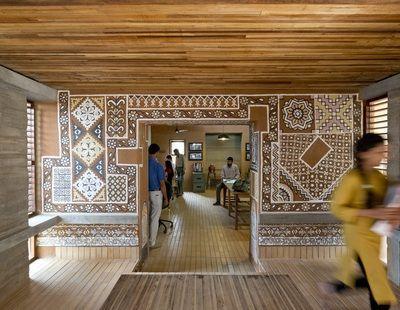

● Hunnarshala Foundation was formed after the massive earthquake of Kutch in 2001 with objectives to construct practices & technologies which are scientifically validated through research initiatives.

● The knowledge of these technologies is transferred to the local artisans who further link it to the contemporary market.
● The Hunnarshala Foundation has three main areas of work namely:
1) Community Empowerment including both Rural and Urban areas.
2) Artisan Empowerment including Artisans Enterprise, Training Program and Technological Intervention.
3) Artisan School
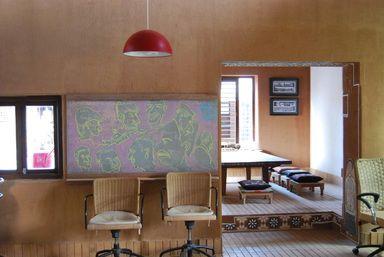
The Initiatives by Hunnarshala:
● Post-quake reconstruction saw large scale implementation of earth construction.
● Three themes have emerged as cross-cutting for Hunnarshala for its direction and works:
● 1) The way in which people are empowered to shape their own habitats
● 2) The habitat solutions that are more environment friendly, sustainable and disaster safe
2.1.1
8
● 3) The local artisanal knowledge and skills that deliver high quality products.
● It offers its knowledge and skills for building designs, settlement planning, social housing, disaster reconstruction, wastewater treatment systems, infrastructure development, etc.

● Hunnarshala promotes that it is essential to stress on technologies and materials that are not very energy consuming as well as recycling the waste our environment generates.
● The campus explores earth, wood, stone and several interpretations of climate and solar passive architecture.
● The Hunnarshala campus building is completely an evolving structure itself. It is designed with a sole reason to demonstrate all the alternative construction technologies.
Campus Planning and Architecture:

9
● The building was not designed in one go, but has evolved over the time with inputs coming from artists, artisans, locals and architects. The whole complex is open for all. The parking of the complex also acts as a bus stop for the residents of the nearby areas.
● The built form is unimposing and of human scale.The asymmetrical planning centered on a courtyard, and earthy textures bring spontaneity and authenticity to this campus.The entrance resembling the old traditional bazaar concept which would open into a lane of different houses and shops.
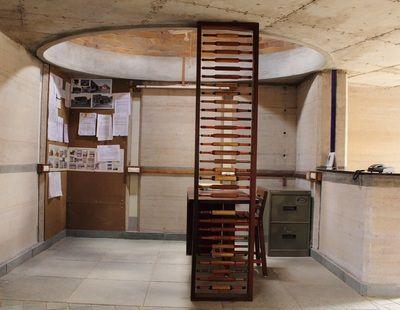
● Building roofs hang low, mix thatch and Mangalore tiles- both supported by slender space frames; walls are rammed earth, interlocking blocks and stone with visible seismic resistance bands reminding that safety is paramount in this high seismic zone. They also have the age-old wattle & daub as both exposed and plastered with lime.


● In their classrooms, blackboards are replaced with frosted glass panels.The kitchen walls were simply precast walls made out of the debris left after the 2001 earthquake and bamboo was added to give strength to it.The whole plan of the kitchen was prepared such that there would be no harm to the tree.
● Karigarshala which is the Artisan School where they train dropouts from the formal education system aged between 16 to 18 in carpentry and masonry. At the end of their yearlong training, they help them find work as artisans.

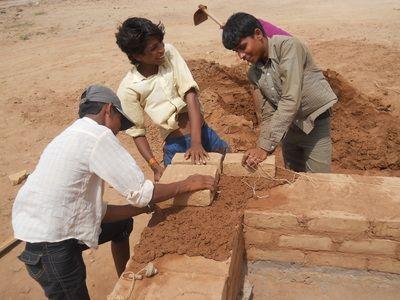
● A large material palette greets visitors to the complex, with differences in each building. For instance, stone dust, industrial waste, construction debris is mixed in soil to build rammed earth walls that give it a white color.
● Best of all, the variety of architectural elements are tastefully synthesized, saving the campus from becoming a mish-mash.
10
MANAV SADHNA ACTIVITY CENTER
● The activity center is located amidst the largest squatter settlement of Ahmedabad, and was created under the initiative of the social NGO, Manav Sadhna.
● The multipurpose activity center serves as an informal school for young children, provides evening education for adults and serves as a training center and activity workshop for the manufacturing of craft based products by women and elderly. The campus also includes a dormitory, an administrative unit and an all-religion meditation unit.
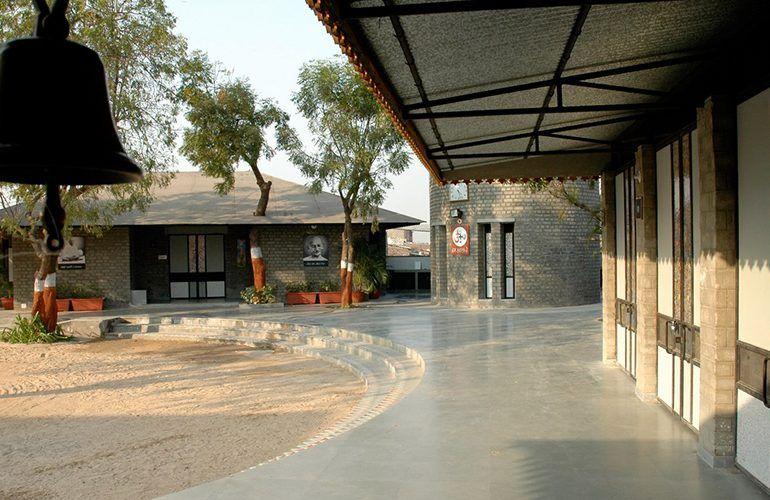
● The campus is built using components prepared through recycling municipal/domestic waste.



● This process simultaneously addresses environmental concerns, economic issues and affordable housing.
● As municipal waste from the domestic sector is used for producing building components, it helps to reduce waste as pollution.
● Through value addition processes of recycling the waste, it provides a means of economic activity for the poor as well as a sense of empowerment.
● Set amidst the largest slum, Manav Sadhna centers are a cluster of multipurpose activity campuses including school, vocational training center, gymnasium, crèche, handicraft unit and community center for festivities.
● Waste such as fly ash, dump fill waste, crate packaging, plastic bottles, glass bottles, rags, wrappers, metals crap, broken ceramic wares, compact disc and electronic hardware etc. have been transformed into walling, roofing, flooring and fenestrations.
● An eco-friendly architectural demonstration, it reduces carbon footprint through waste recycling, empowering the poor (inclusive of waste pickers in the slum) by generating economic opportunities through value addition and developing alternative building products and a community space for them.
2.1.2
11
● The campus is built as a live demonstration for the application of recycled waste as affordable, aesthetically pleasing and efficient building components.
● The products developed for this project, which incorporate municipal/domestic waste and are prepared with simple hand operated tools, and produced partly through local help of the end users, are demonstrated in the walls, roofs/slabs, doors and windows.
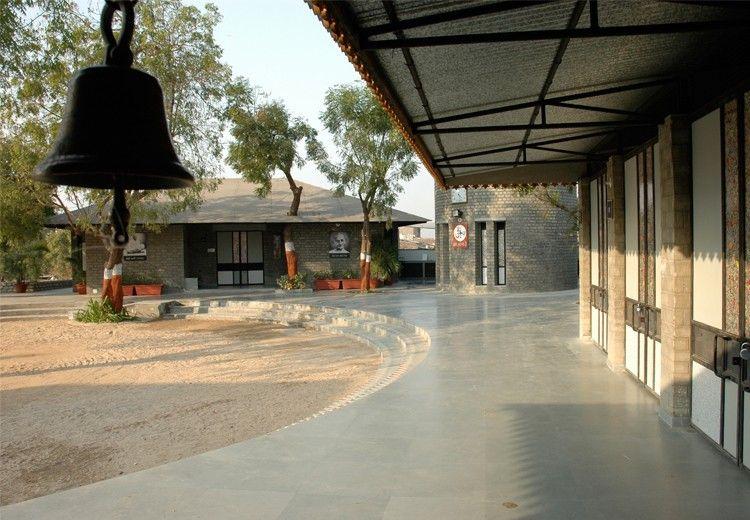

● There are six types of materials and techniques used in the making of the walls. These include: cement bonded fly ash bricks, mold-compressed bricks made from landfill site waste residue, stabilized soil blocks, recycled glass bottles, recycled plastic bottles filled with ash and waste residue, and vegetable crate wood paneling in the inner partition walls.
● The alternative building components created through such waste recycling have been lab tested for their strength and other performance criteria, which they successfully fulfill. Task performance and costs were the basic bottom lines with which they were created, so the newly developed components and building techniques continue to be comparable by cost, better performing & aesthetics.
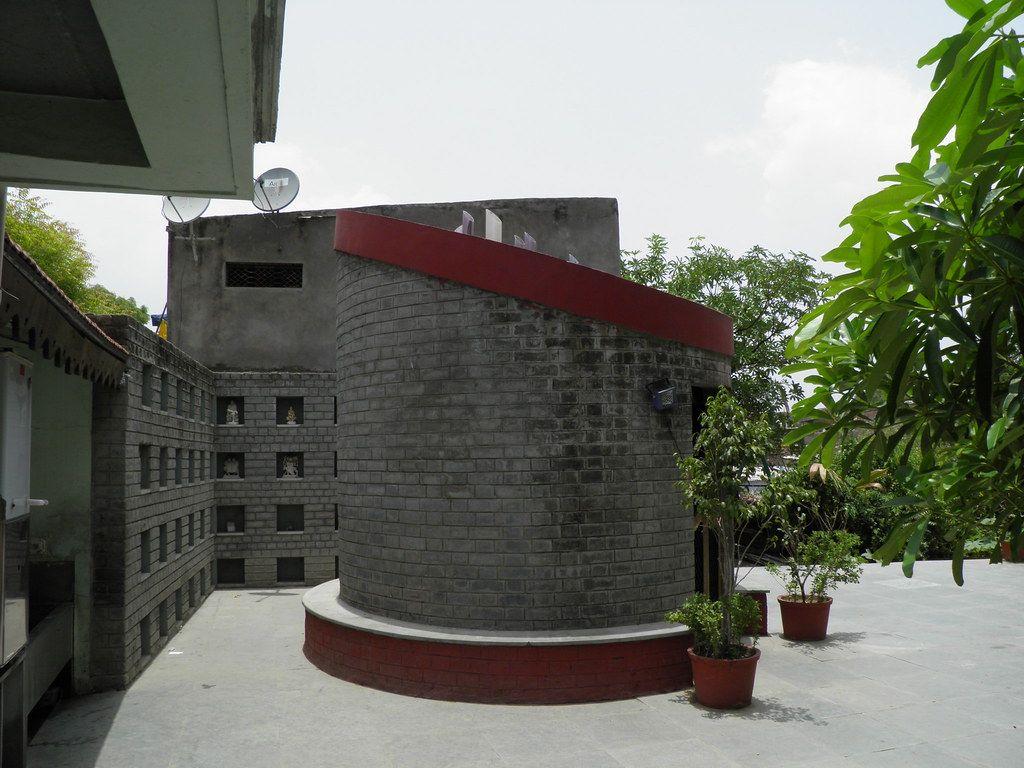
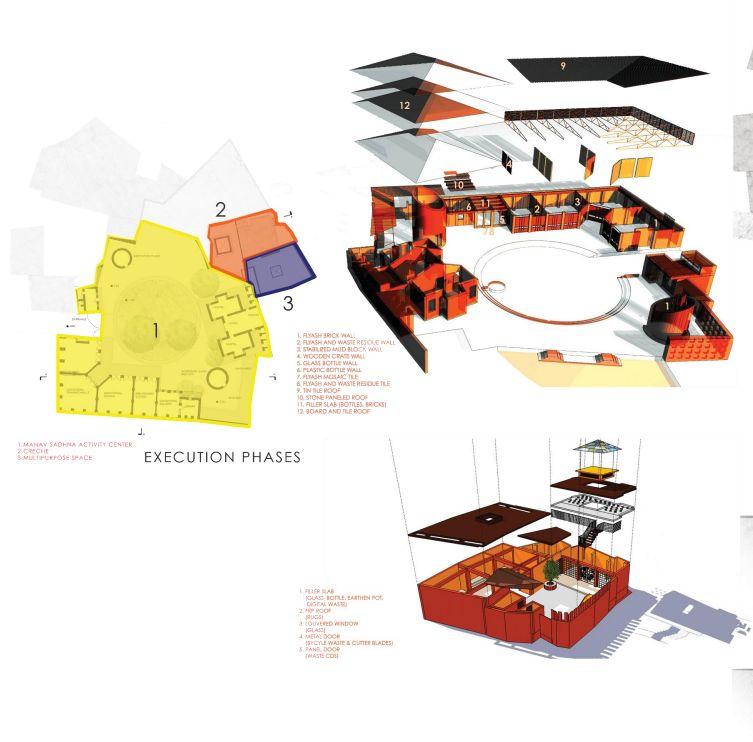
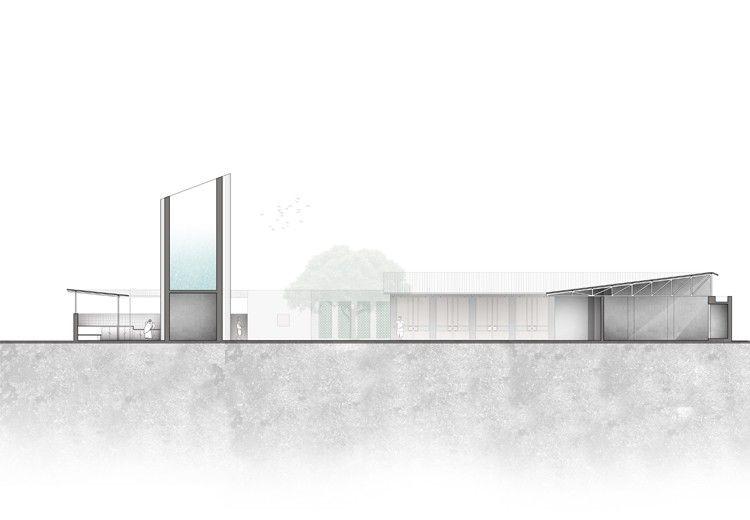

12
● Manav Sadhna activity center is worthy of consideration for the award as it is an apt example of innovative, contextually appropriate, socially responsible and environmentally sensitive architecture for the improved quality of life of the urban poor. It has demonstrated that waste can become a resource and can be recycled as affordable and durable alternative building components.



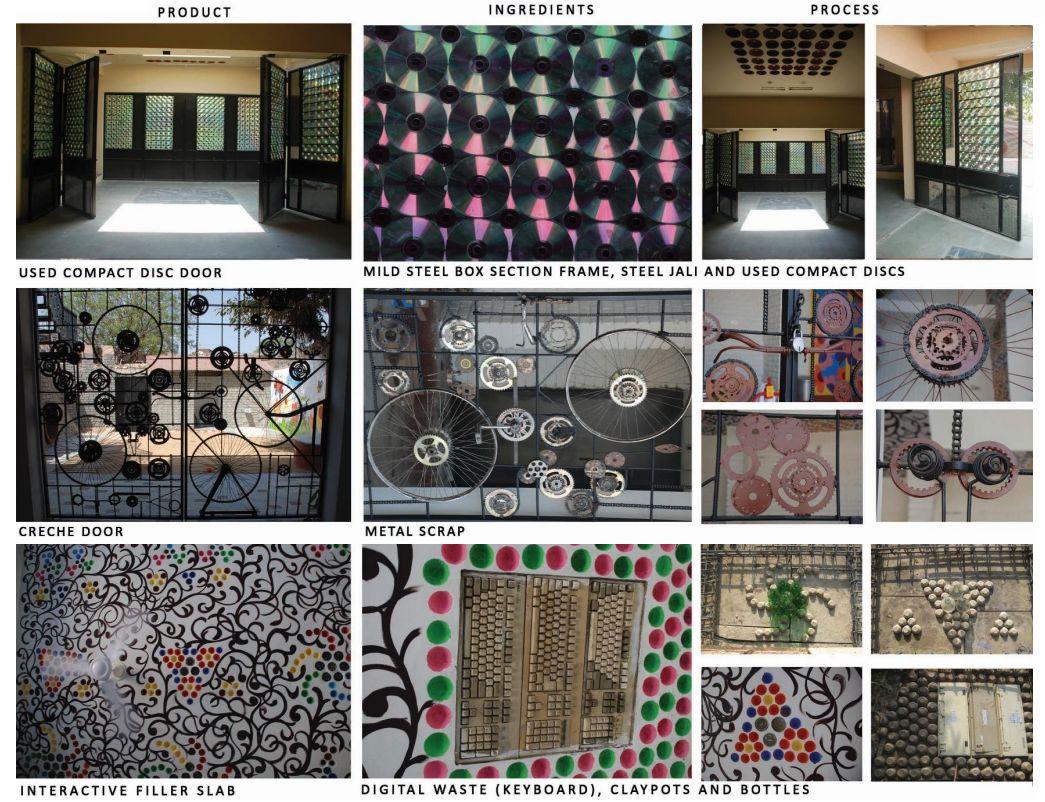


13
GRAMAVIDYA
● Gramavidya is a voluntary organization for research and dissemination of alternative technologies promoted by a group of professionals, academicians, scientists and technologists with dreams about creation of a self-reliant and sustainable livelihood through alternative, environmentally friendly appropriate technologies.
● World around us today is really concerned about sustainability and exploring green technologies sincerely. But it was in the mid-seventies of the twentieth century, the search for alternatives in building technologies was instituted at ASTRA (Now CST-Center for Sustainable Technologies) and Department of Civil Engineering, Indian Institute of Science, Bangalore.
● Simple, cost-effective, environment friendly, energy efficient technologies were developed and field tested.
● Mrinmayee is the office of Gramavidya and is involved in alternative ideas in architecture which stresses on low embodied energy and eco-friendly designs to construct load bearing masonry buildings & provides services in architectural and structural design.
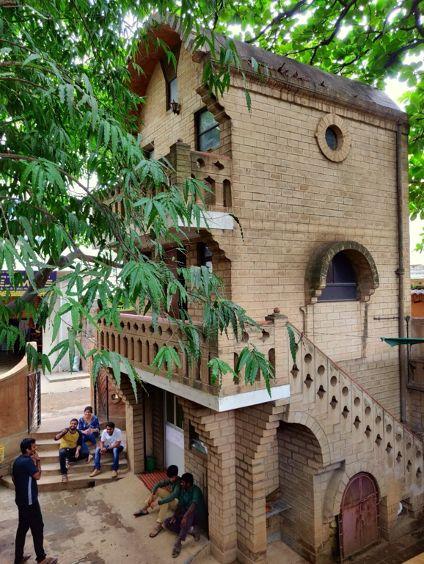


● The interest shown by many people who were captivated by the twin advantages of cost reduction and elegant appearance paved the way for the setting up of Mrinmayee on mud blocks and building alternatives.
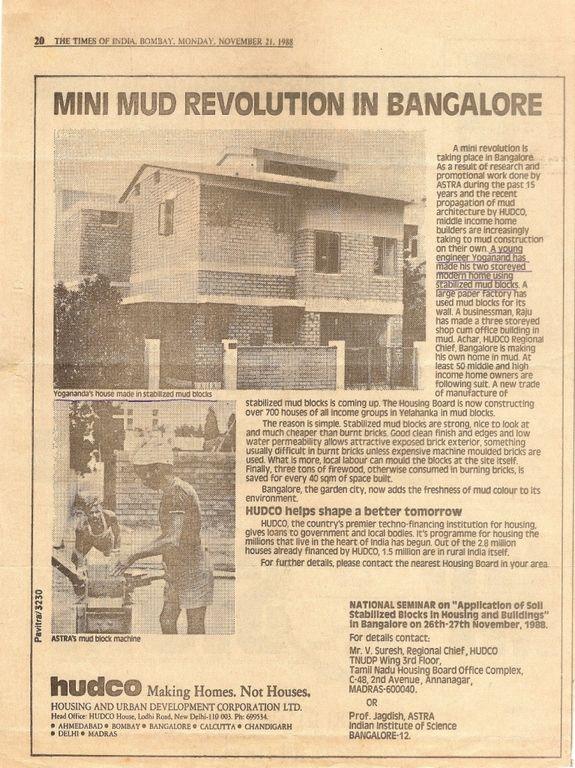
● Mrinmayee Testing Lab made its beginning by getting involved in testing various kinds of soils and arriving at the correct mix design to produce good quality SMB’s with the required wet compressive strength and durability.
● Hands-on workshops are conducted by Mrinmayee on a regular basis, where the participants can actively take part to get practical knowledge. These workshops have seen architects, civil engineers, contractors, students, home makers, masons et al. enroll for the programme.
● Artisans on-site training is also given wherever the projects are executed using alternative technologies.
2.1.3
14
● Mrinmayee Testing Lab made its beginning by getting involved in testing various kinds of soils and arriving at the correct mix design to produce good quality SMB’s with the required wet compressive strength and durability.

● Hands-on workshops are conducted by Mrinmayee on a regular basis, where the participants can actively take part to get practical knowledge. These workshops have seen architects, civil engineers, contractors, students, home makers, masons et al. enroll for the programme.
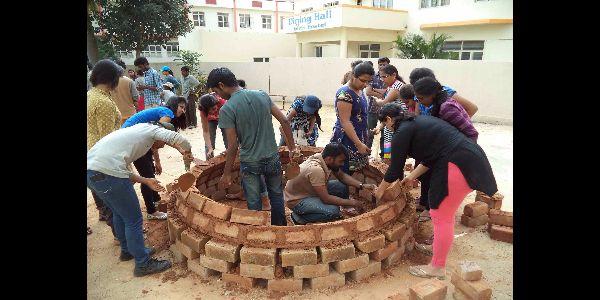
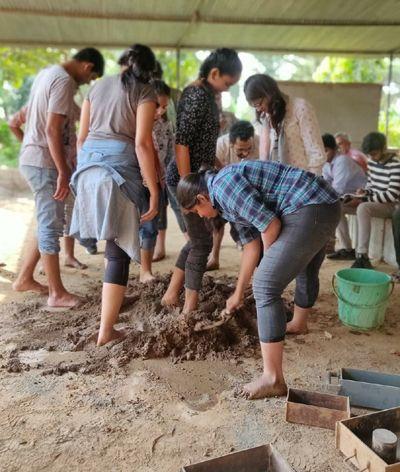

● Artisans on-site training is also given wherever the projects are executed using alternative technologies.

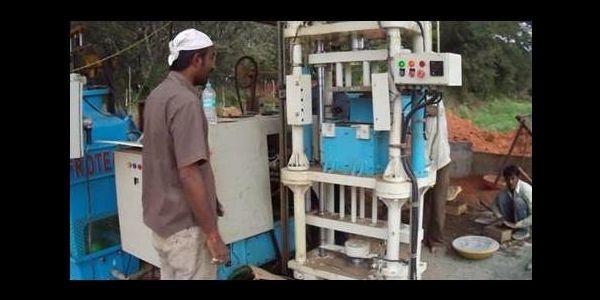
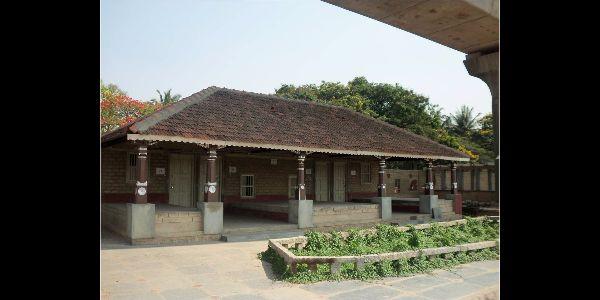


15
● Gramavidya Research and Development:
CHAPTER 3: ARCHITECTURAL PROGRAM AND TENTATIVE SITE
3.0 OVERALL INSTITUTE CONCEPT
‘Ehsaas’- Center For Learning, Exploration And Innovation For The Built Environment
● The Threatened Climate Catastrophe Has Significantly Increased Interest In, And Awareness Of, The Necessity For Sustainable Building Techniques And Thus, Specialisation And Certification Courses Which Promote Alternative Building Techniques.
● Awareness Centre Giving Hands-On Experience With Materials.
● Exploratory, Innovation, Research And Development Center.
Target Audiences:
Architects
Entrepreneurs
Fineartist
Sculptor
Young People In Vocational Training
Craftspeople And Artisans Companies Engineers
Contractors Builders Materials Producers/Dealers Investors Students Self-Builders
Anyone Interested In Ecological Construction And Natural Materials.
3.1 PROPOSED CURRICULUM
3.1.1
BASIC CONSTRUCTION COURSES: (10% OF BUILT UP)
Specialisation Course 1:
● Brick Masonry (Brick Bonds, Vaults, Dome, Arches)
Specialisation Course 2:
● Parametric Architecture With Brick
Specialisation Course 3:
● Introduction To Wood Technologies: Machining And Manufacturing Carpentry
Glueing And Finishes
Conservation Physics Of Wood / Drying Wood Energy
Specialisation Course 4:
● Buildings And Structures Technologies: Vertical And Horizontal Load-Bearing Systems Roof Load-Bearing Systems
Cladding
Pathology In Building Structures Assembly And Stability Of Structures
Structural Mechanics Timber Joineries
Specialisation Course 5: (1 Year) ● Advanced Design Of Timber Structures
Specialisation Course 6: (10 Months) ● MMTD - Master In Mass Timber Design
Specialisation Course 7: (Individual Workshops Around The Year) ● Carpentry Workshop ● Timber Vault Workshop ● Japanese Carpentry ● Light Frame And Prefab ● Tree House Construction
Individual Material Area Program:
Reception and Admin Area ● Workshops, Classrooms, AV Rooms ● Construction Yard ● Research And Development Lab
Storage Of Materials, Equipments
16
●
●
3.1.2 EARTH COURSE: (25% OF BUILT UP)
Specialisation Course 1: (8 Weeks)
● Introduction To Earth Architecture: From Raw Material To Earth Mix Soil Identification, Stabilization & Soil Tests. Prefabricated Elements (Adobe And Superadobe) Compressed Stabilised Earth Blocks(Cseb) Earth Arches,Vaults & Domes(Avd)
Specialisation Course 2: (10 Weeks)
● Building With Earth: Load Bearing And Formwork Techniques For Earth Building Earth Masonry,Cob,Rammed Earth (Traditional And Modern)
Earth Bag, Wattle & Daub.
Specialisation Course 3: (6 Weeks)
● Repair And Conservation In Earth Building (Maintain, Repair, Renovate, Restore Earthen Buildings And Plasters)
● Earth Building Market (Marketing, Estimating, Invoicing)
Specialisation Course 4: (6 Weeks)
● Pottery
● Application Of Clay Plaster
● Natural Plasters Using Admixtures Derived From Plants And Animals
● Murals And Sculptures On Mud Walls
● Interior Design, Decorative Techniques
Specialisation Course 5: (Individual Workshops Around The Year)
● Poured Technology
● Earth Shelter Technology
● Straw And Clay Technology
● Papercrete Technology
● Dug Out Technology
● Covered Technology
● Filled In Technology
● Cut Block Technology
● Shaped Technology
● Earthquake Resistant Earth Construction
● Earth Fast & Movable Construction
Individual Material-Earth Area Program:
● Reception
● Admin Area
● Workshops For Courses
● Classrooms For Courses
● Av Rooms
● Construction Yard
● Research And Development Lab
● Soil Testing Lab
● Material Testing Lab
● Storage Of Materials
● Storage Of Equipments
● Sanitation
3.1.3 BAMBOO COURSE: (25% OF BUILT UP)
Specialisation Course 1: (2 Years)
● Diploma In Bamboo Technology
Specialisation Course 2: (8 Weeks)
● Introduction To Bamboo As Material: Theory About Bamboo And Its Uses Tools And Techniques Cutting, Joineries And Splitting Bending And Straightening Bamboo Treatment
Specialisation Course 3: (10 Weeks)
● Basic Bamboo Construction Course: Bamboo Footing, Walls, Roof Bamboo Structural System: Post, Beams And Lintels Bamboo Scaffolding, Reinforcement
Specialisation Course 4: (8 Weeks)
● Intermediate Bamboo Construction Course: Basic Bamboo Modelling Bamboo Joints And Joinery Techniques Cutting And Splitting Bamboo Bending And Straightening Prefab Components And Structure Erection
Specialisation Course 5: (12 Weeks)
● Advance Bamboo Construction Course: Bioorganic Architecture Natural Sound Absorber Curved Bamboo Bamboo Screening System Bamboo Reinforced Concrete Disaster Relief Structure From Bamboo
Specialisation Course 6: (Individual Workshops Around The Year)
● Skill Development Workshop: Dynamic Geometry With Bamboo Bamboo Furniture Making Workshop Bamboo Toy Making Workshop Bamboo Bridge Ephemeral Structures Sculptures
Bamboo Boats Bamboo Charcoal And Briquettes
17
Individual Material-Bamboo Area Program: Reception
Admin Area Workshops For Courses Classrooms For Courses Av Rooms
Construction Yard Research And Development Lab Bamboo Strength Testing Lab Material Testing Lab Storage Of Materials Storage Of Equipments Sanitation
3.1.4 ‘WASTE AS RESOURCE’ COURSE: (15% OF BUILT UP)
Specialisation Course 1: (6 Months)
● Design For Disassembly Or Deconstructivism: Mechanical Assembly, Assembly Through Hierarchical Lifespan Of Material, Assembly To Fixation, Modularity, Homogeneity, Uniformity, And Minimal Connections To Understand A Potential Pattern For Designing The Next Generation Of Sustainable Buildings Raising The Current Concern Of Environmental And Economical Assessment. Management Of Construction And Demolition Waste
● Individual Material- C&D Waste Area Program:
● Reception
● Admin Area
● Workshops For Courses
● Classrooms For Courses
● Av Rooms
● Construction Yard
● Research And Development Lab
● Concrete Strength Testing Lab
● Storage Of Materials And Equipments
● Sanitation
Specialisation Course 2: (6 Week Course)
● Cargotecture: Repurposing Of Shipping Containers
Shipping Containers, Container Architecture Examples, Container Housing, Resources
Specialisation Course 3: (Individual Workshops Around The Year)
● Design Of Temporary And Deployable Structures Using Steel
● Drash (Deployable Rapid Assembly Shelter) Using Steel
● Geodesic Geometries And Steel Domes
Individual Material- Steel Waste Area Program: ● Reception ● Admin Area ● Classrooms For Courses
● Av Rooms
● Construction Yard ● Research And Development Lab
● Storage Of Materials And Equipments
● Sanitation
Specialisation Course 4: (Individual Workshops Around The Year)
● 3D Printing
● Agro Waste As Source Of Building Material (Mycelium, Rice Husk Ash)
● Solid Waste As Source Of Building Material (Ecoladrillo)
● Ferrock, Hempcrete, Ash Crete, Bio Concrete
3.1.5
COMMON AREA PROGRAM: (25% OF BUILT UP)
● Exhibition Area ● Display Gallery
Auditorium
Canteen ● Restaurant
Dormitories For Learners
Dormitories For Artisans
Dormitories For Experts
Sanitation
Co-working Studios ● Admin
Workstation ● Office Area ● Meeting Room
Conference Room ● Waiting Area
Display Portion ● Sanitation
18
●
●
●
●
●
●
●
●
●
SITE SELECTION:
The Center has to be located to place which is near to the required material resources as well as near a well established Institute for faster promotion and enrollments. This can be an extension or a new proposal as a whole site under the name of well defined Institution which promotes education for environment and sustainable development. One of the Institute which spreads public awareness and understanding of the environment with a view to promoting the conservation and sustainable use of nature and natural resources is CEE, located in Ahmedabad.
3.2.1 Centre for Environment Education (CEE)
Centre for Environment Education (CEE) is a national institution engaged in developing programmes and material to increase awareness about the environment and sustainable development.CEE was created in recognition of the importance of environmental education in India's overall environment and development strategy. The result of a unique partnership between government and a non-governmental institution, CEE was established as a Centre of Excellence in 1984, supported by the Ministry of Environment and Forests (MoEF), Government of India. CEE has inherited the rich multi-disciplinary resource base and varied experience of the Nehru Foundation for Development, its parent organisation, which has been promoting educational efforts since 1966 in the areas of science, nature study, health, development, and environment. Today, CEE works for a wide range of sectors, target groups and geographical areas. CEE sees a major opportunity in the UN Decade of Education for Sustainable Development (2005-14) to further contribute towards sustainable development.
CEE's Objective:
To improve public awareness and understanding of the environment with a view to promoting the conservation and sustainable use of nature and natural resources, leading to a better environment and a better quality of life. To this end, CEE develops innovative programmes and educational material, and builds capacity in the field of education for sustainable development (ESD).
CEE's Strategies:
● Maximise the scope of EE with state-of-the-art thinking, developments, innovations and perspectives in the areas of Environment and Sustainable Development
● Develop programmes that are adaptable to different geographic, cultural, social and economic contexts
● Partnering with a view to utilising the complementary strengths of other organisations, so as to avoid duplication of effort, and to network effectively towards the synergistic convergence of ideas and goals
● Develop programmes and materials to build on the existing strategic opportunities and facilities for EE
● Encouraging and supporting other agencies in the field of EE and ESD to develop similar materials and programmes based on their specific needs and situations.
● Build synergies between the Government, NGOs and CEE for comprehensive impact.
● Identify the key entry points for different thrust areas, and key targets for initiating and consolidating gains, to achieve a multiplier effect.
● Conduct workshops/ seminars to facilitate dialogue between various stakeholders, including the government and the society, on the environmental implications of growth and development
CEE's Vision and Mission:
To be an institution of excellence that, in partnership with others, plays a significant role in local, national and global efforts towards sustainable development through innovations, and being at the cutting edge of Environmental Education and Education for Sustainable Development. It is to integrate education as a key driver for change in demonstrating and advancing sustainable practices in rural and urban communities, and in business and the public sector, and in meeting challenges of global issues such as climate change and biodiversity conservation.
3.2
19
3.2.2 Centre for Environment Education (CEE) Centers in India
1) Goa, India:
CEE:
● Has been working in the state of Goa since 2001. The state office at Goa is an effort to initiate long-term Environmental Education programmes and activities that are responsible to local needs, intensive in focus and extensive in reach.

● Besides extending core programmes of the Centre to Goa, CEE Goa is developing a variety of new projects and initiatives in the region. Specific content areas include programmes related to school developing locale-specific material, interpretation, capacity building and networking.
● Architects, planners and others with green caps and fingers are unveiling a plan to promote use of green principles for eco-friendly infrastructure, necessitated by climate change.
● Confederation of Indian Industry (CII, Goa) and Indian Institute of Architects (IIA) Goa chapter have initiated a joint effort towards creating a cell in Goa to promote green buildings for housing, industries and commercial sector.
● Conceding that awareness is just building up in Goa at the moment, D'Cruz said research shows that conventional buildings consume 40% of the energy used on earth.
● As a first step, Indian Green Building Council (IGBC) is trying to set up its Goa cell with assistance from Goa chapters of CII and IIA.
IIT GOA:
● IIT Goa will strive to become a unique institution of higher learning, offering state of the art education, research, and training in science and technology to have impact on society, environment and global challenges.
● The mission of IIT Goa is to impart knowledge and provide unique learning experience to prepare students to be responsible leaders, managers, entrepreneurs, and professionals who will play a leading role in the sustainable development of Goa and the nation as a whole.
● The learning experience will reflect the human values of the state—diversity and inclusion.
● In the short term, IIT Goa will have a strong focus on quality education and advanced multidisciplinary programs, and in the long term, it will progress towards a self-sustaining institute.
2) Gujarat, India:

● Centre for Environment Education Ahmedabad was established as a Centre of Excellence under the Ministry of Environment, Forest and Climate Change, Govt. of India, working in the field of Environmental Education and Education for Sustainable Development.
● As a national institution, CEE’s mandate is to promote environmental awareness nationwide. CEE develops innovative programmes and educational material and builds capacity in the field of Education for Sustainable Development (ESD). It is committed to ensure that Environmental Education (EE) leads to action for sustainable development.
● It undertakes field projects that demonstrate and validate the role education can play in sustainable development.
20



3.2.3 Sites Option 21 Site 1: Near IIT Goa Site 2: CEE Ahmedabad Site 3: CEE Goa
1. https://www.earth-auroville.com/building_with_earth_en.php
2. https://www.iitb.ac.in/en/ioe/major-proposals
3. https://issuu.com/deekshamittal02/docs/final_manual__publish_online_
4. https://unesdoc.unesco.org/ark:/48223/pf0000184743
5. https://cst.iisc.ac.in/cst/people
6. https://www.devex.com/organizations/mahatma-gandhi-institute-of-education-for-pe ace-and-sustainable-development-unesco-mgiep-120903
7. https://terraversa.es/the-12-techniques-of-earth-construction-english/
8. https://www.infurnia.com/blog/earth-architecture-innovative-techniques-and-its-pote ntial
9. https://onlinecourses.nptel.ac.in/noc19_ce40/preview
10. https://www.bamboo-earth-architecture-construction.com/sustainable-architecture/
11. https://nios.ac.in/online-course-material/vocational-courses/bamboo-cultivation-(673) .aspx
12. https://nios.ac.in/online-course-material/vocational-courses/bamboo-cultivation-(673) .aspx
13. https://www.giantgrass.com/project/skill-development-workshop/
14. https://theconstructor.org/building/bamboo-as-a-building-material-uses-advantages/1 4838/
15. https://www.re-thinkingthefuture.com/materials-construction/a3506-5-things-archite cts-can-do-with-bamboo/
16. https://weburbanist.com/2018/11/21/designed-for-disassembly-architecture-built-with -its-own-end-in-mind/
17. https://archinect.com/features/article/150067785/recycled-buildings-how-to-design-for -disassembly
18. https://archinect.com/features/article/150067785/recycled-buildings-how-to-design-for -disassembly
19. https://archinect.com/firms/project/29046912/design-technology-block-st-james-school /149977434?utm_content=buffer86596&utm_medium=social&utm_source=pinterest.c om&utm_campaign=buffer
20. https://www.re-thinkingthefuture.com/rtf-fresh-perspectives/a1990-cargotecture-thearchitecture-of-shipping-containers/
3.3
REFERENCES
22
 -Manushi Sehulbhai Sheth (34)-
-Manushi Sehulbhai Sheth (34)-














































